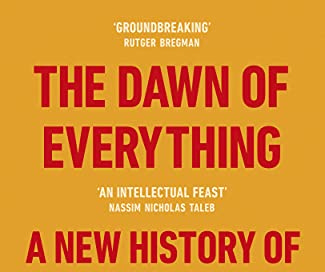You know your internal monologue?
Is it?
Is it really a monologue?
Or are you talking to someone?
I don’t know about you, but my thoughts tend to be a little more back and forth. I know what kind of mood I’m in, depending on whether I call myself Andy (good), Andrew (bad) or You Fucking Moron (furious).
Odd, isn’t it?
If you’re the same, don’t worry. We’re not mad. See, I’ve been reading a book about anthropology, archaeology and the development of humanity.
This one:
A few chapters in, this little nugget of wisdom appeared:
Human thought is inherently dialogic.
How mad’s that? We think, as a species, in dialogue. Either with ourselves, or an imagined other. All that l'esprit de l'escalier where you finish an argument with a person after you’ve stormed out and they can’t hear you?
Not childish, Laura.
And not chaos theory, Doctor Malcolm.
Human nature.
We think in conversations.
We write, unfortunately, in tedious monologues. At least, some of us do.
I had a chat at a conference last month, and someone asked me if I had one tip to help her better at writing.
I told her what I always tell people.
She laughed, I pretended I was joking, then I gave her some actual advice.
Think of one person. Just one person.
Imagine having a conversation with them, and just write down the parts you’d say out loud.
Tweak it so you don’t sound like Jeff Goldblum uhh-ing and ahh-ing and ha-haaawr-ing, leave little spaces for them to reply in their heads, and then you’re 90% of the way there.
The rest is just practice to lead them towards the kind of mental replies you’re aiming for.
There’s nothing magic about it. You don’t even need to know all about the psychology of the human mind, or the fact that we’re all secretly lizards.
Just remember the one key thing about people.
You remember it right? Let’s say it together.
We think in conversations.
That’s the secret.
We think in conversations. So we should all write in them too.
Right?
Something mint - the power of conversation
See, because we think in conversations, adverts that drop us into a conversation trigger the imaginative parts of our brains.
Here’s a monologue.
Coercive partners often keep a close eye on the spending of the abused person.
They track both how much a person spends, and what they buy.
It’s a pattern of behaviour that often extends to tracking locations.
Gosh. That’s horrid. Stroke my chin, stroke my chin. This kind of behaviour is clearly problematic and concerning. This sounds like an issue. I hope someone somewhere does something.
I’m not making light of domestic abuse. It’s fucking awful. But present that desperately important information as a monologue, and you depersonalise it. It lacks all that immediacy you’d get.
Now look at these three adverts.
Art direction, superb. The red flag is a really solid concept, but why is this much more powerful than the monologue? The information imparted is the same.
Because it’s making you part of the conversation. It’s even got the pauses. You don’t read those ads. You hear them.
You hear them as someone who needs your help, talking to you directly.
So instead of the dispassionate “someone should do something” you get that much more immediate, visceral, human reaction of “this woman is asking for help and I need to help her.”
We think in conversations. Even tough conversations. Even unpleasant ones.
Sorry for the tonal shift. If you feel uncomfortable, you can soothe your conscience by donating to Refuge.










